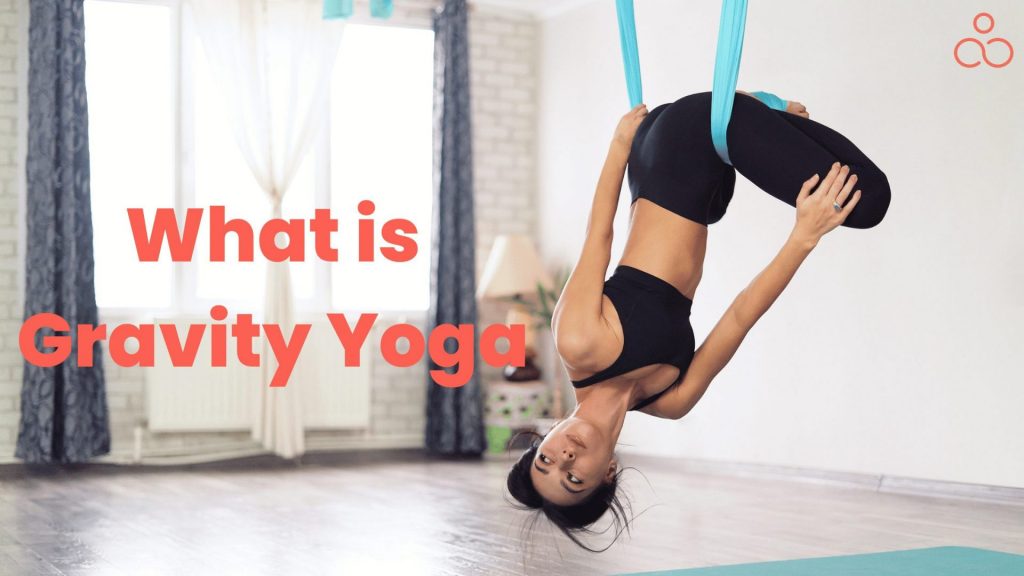Want to boost your Yoga experience? Focus on gravity-based techniques to improve mobility, flexibility, and joint movement with minimal effort.
Curious about what is gravity Yoga, anti-gravity Yoga, or anti-gravity Yoga hammocks? You’ve come to the right place! Dive in and find answers to all your questions.
Let’s flex and float together!
What is gravity Yoga? How is it different from traditional Yoga?
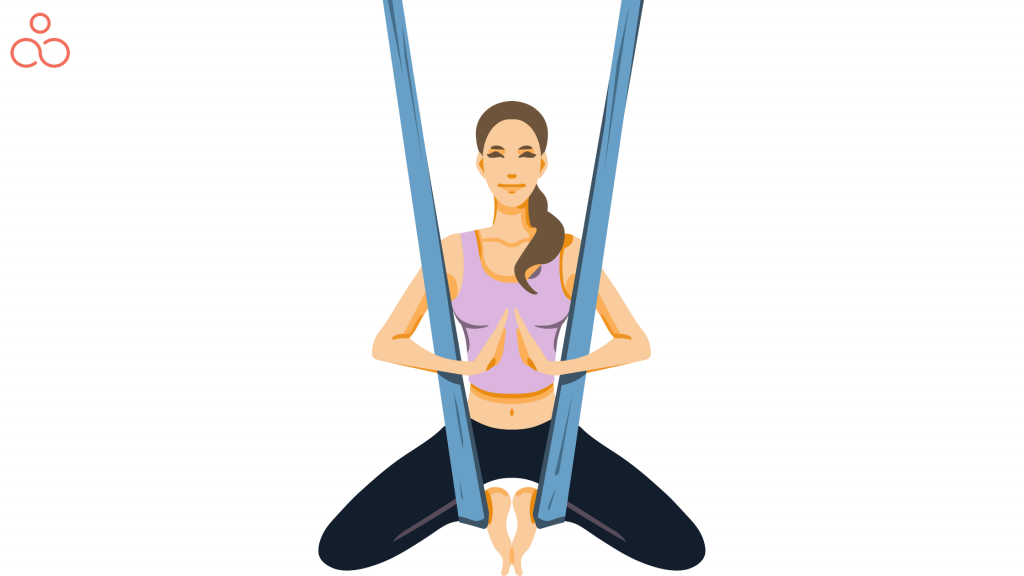
Gravity Yoga, founded by Lucas Rockwood in 2007, is a relatively new Yoga style that has quickly gained popularity and is now one of the fastest-growing. This type of Yoga involves holding poses that focus on improving flexibility for 2 to 5 minutes or longer.
- Gravity Yoga is unique compared to other styles like Ashtanga or Hatha, as it focuses solely on passive poses.
- According to Rockwood, in gravity Yoga, the body remains completely relaxed or limp to rely on the force of gravity to stretch the body.
- Although gravity Yoga is similar to Yin Yoga, which also emphasizes long, deep stretches, there are notable differences between them.
- For instance, Yin Yoga, based on Taoist ideas and ancient Chinese philosophies like the channeling of Qi energy or chakra, is a profoundly spiritual and physical practice.
- Another significant distinction is that standing poses, such as Standing Forward Fold (or Bend) (Uttanasana) or Upward Facing Bow Pose (Urdhva Dhanurasana), are prevalent in gravity Yoga but often disregarded in Yin Yoga.
Gravity Yoga vs Traditional Yoga
Gravity Yoga and Traditional Yoga are two different types of Yoga practices with their own unique set of benefits and focus.
| Parameter | Gravity Yoga | Traditional Yoga |
| Origins | Developed in the early 2000s, influenced by traditional Yoga and aerial arts. | Originated in ancient India, around 5000 years ago. |
| Equipment | Aerial hammock, Yoga mat. | Yoga mat, optional props like blocks, straps, and bolsters. |
| Target Audience | Suitable for people with prior Yoga experience and a basic level of fitness. | Suitable for all ages, fitness levels, and experiences. |
| Popular Styles | Aerial Yoga, AntiGravity Yoga, Suspension Yoga | Hatha Yoga, Vinyasa Flow Yoga, Ashtanga Yoga, Yin Yoga, Iyengar Yoga |
| Difficulty Level | Moderate to advanced, depending on the specific practice. | Ranges from beginner to advanced, depending on the style and practice. |
| Duration of Poses | Held for 3-5 minutes or longer. | Varies, depending on the style and intention; can range from a few seconds to several minutes. |
| Physical Benefits | Improved flexibility, increased core strength, and decompression of the spine. | Improved strength, flexibility, balance, and body awareness. |
| Mental Benefits | Reduced stress, enhanced focus, increased self-confidence. | Reduced stress, increased focus, mental clarity, and inner peace. |
| Accessibility | Requires specialized equipment and studios or gyms with aerial Yoga classes. | Widely available in studios, gyms, community centers, and online classes, with various styles to choose from. |
3 Important Founding Principles of Gravity Yoga
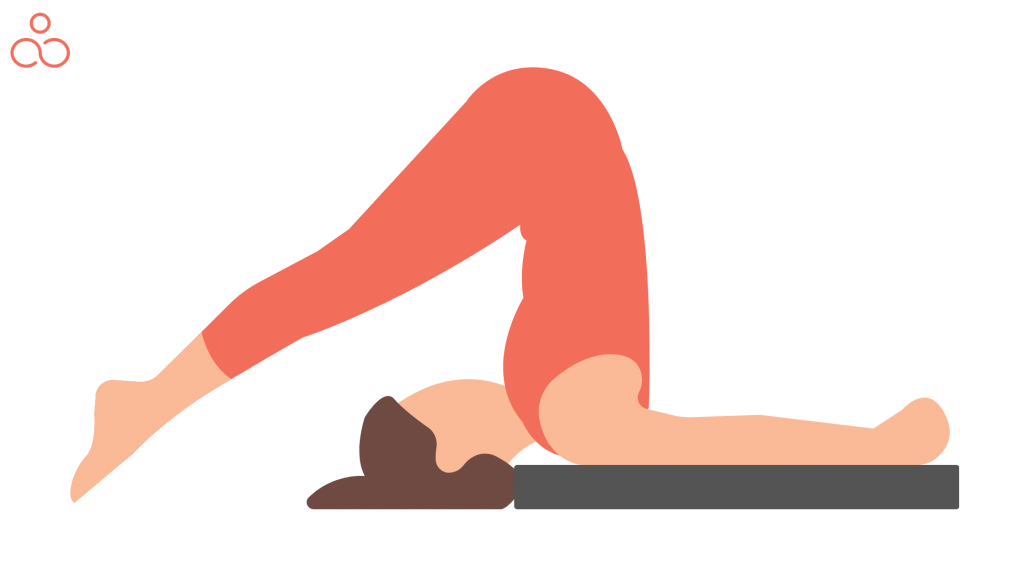
1. Wet Noodle/Hang Loose
The first rule is to let loose. The fundamental idea of gravity Yoga is to relax oneself into the stretch completely. You may let gravity act more efficiently on your body by letting go of all tension without using any muscles.
2. 4/8 Synchronized Breathing
The second rule is to practice 4/8 breathing, or inhaling for four counts and exhaling for eight counts via the nose.
The theory is that by slowing our breathing and deepening our exhalations, we activate our parasympathetic nervous system, inhibiting our stretch reflex. This technique is meant to help us focus and slow our breathing.
To put things in perspective, the stretch reflex occurs when our muscles contract in reaction to being stretched. Our bodies instinctively contract the respective muscles in response to trying to keep them within their normal physiological ranges.
To prevent over-extension and injuries, our body takes this precaution. It is vital to control this response during flexibility training since it makes pushing ourselves beyond our comfort zones harder.
3. Meet or Beat Your Hold Time
The third rule is to strive for a longer hold duration relentlessly.
According to gravity Yoga, the gating element for flexibility is “duration under passive strain” (also known as how long you hold these challenging postures).
The better you can hold any of these positions without feeling uncomfortable, the more flexible you will become. As a result, postures are timed, and advancement is monitored to increase holding duration with each practice continuously. The typical gravity Yoga hold durations are 2–5 minutes, although they can last longer.
Some Of The Important Benefits Of Gravity Yoga That’ll Make Your Day
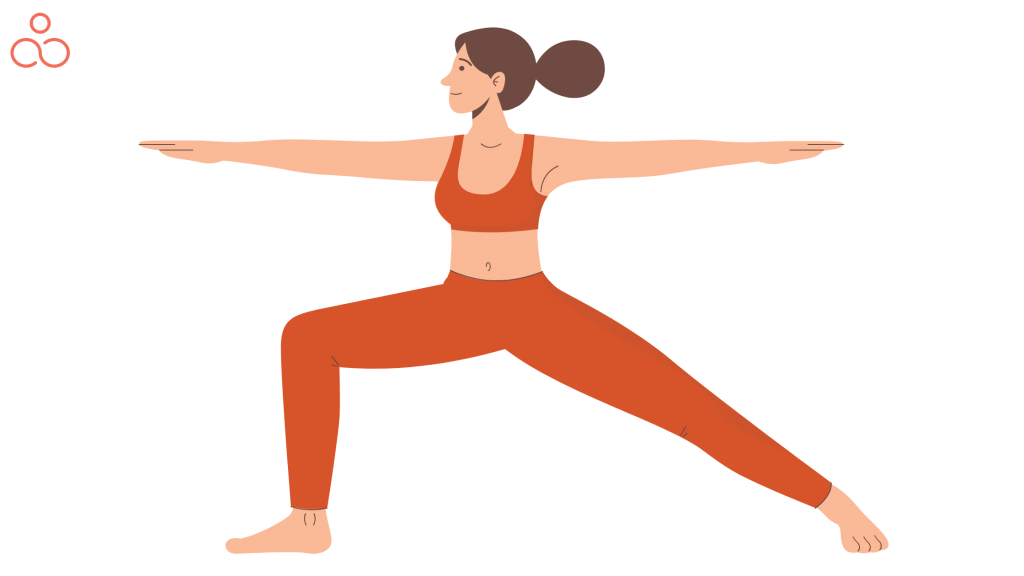
Flexibility
- The practice of gravity Yoga will expand your range of motion and flexibility.
- Regular practice of gravity Yoga may significantly enhance our bodies’ alignment and posture while reducing the impact that aging has on our flexibility.
- As a result, we become more injury-resistant as our bodies adapt to executing various actions and become more pliable. This is one of the main reasons gravity Yoga is a fantastic addition to other types of exercise.
Pain Relief
- The second advantage is that this particular Yoga style may significantly reduce discomfort.
- The specific goal of gravity Yoga is to release tightness and tension that has built up in our muscles and connective system, which is frequently the cause of muscular discomfort, joint pain, and cramping.
- Gravity Yoga is believed to be able to target particular regions with cognitive mobility training to lessen and, in some cases, even eliminate these aches.
- This Yoga can help you live a more active life outside of the Yoga classroom by relieving these aches that may limit your regular activities.
Relaxation
Your body and mind may both relax with the aid of gravity Yoga. Studies demonstrate that this Yoga approach offers many of the same physiological advantages as yin Yoga, including stress reduction, reduced heart rate, better mood, and enhanced sleep, due to the slow tempo of the practice and its emphasis on regulated breathwork.
Increased strength
By using your own body weight and gravity to challenge your muscles, gravity Yoga can help build lean muscle mass and increase strength.
Better balance
The use of gravity can also help refine your sense of balance, which is essential for many Yoga poses and activities in daily life.
Reduced Stress Levels & Overall Wellness
In addition to physical benefits, Gravity Yoga can also lead to decreased stress levels and increased overall health and well-being. By focusing on breath and mindfulness, practitioners of Gravity Yoga can reduce stress and anxiety and improve their overall mental health and well-being.
5 Easy Gravity Yoga Poses to Practice at Home
1. Butterfly Pose/Throne Pose (Baddha Konasana)
Benefits
Opens up and increases flexibility in the inner thighs, hips, groin area, ankles, knees, and shoulders/chest.
Steps to do it
- Sit down and extend your legs straight out in front of you to start (Dadasana).
- Take a deep breath and bend your knees, bringing your heels to your buttocks and keeping your feet flat on the ground.
- Breathe out as you gently let both legs fall to the side. Bring the soles of the feet together while they do this and press them flat against one another (Baddha Konasana).
- Take a deep breath and bend backward, first lowering your elbows to the floor, then lowering your entire body until your back is flat against the ground.
- Arms should be relaxed by your side with the palms facing up and shoulders away from the ears.
- Breathe in and out at a 4/8 rhythm for at least two to five minutes. Let gravity pull your knees, thighs, and tailbone closer to the floor while remaining totally relaxed.
2. Standing Forward Bend (Uttanasana)
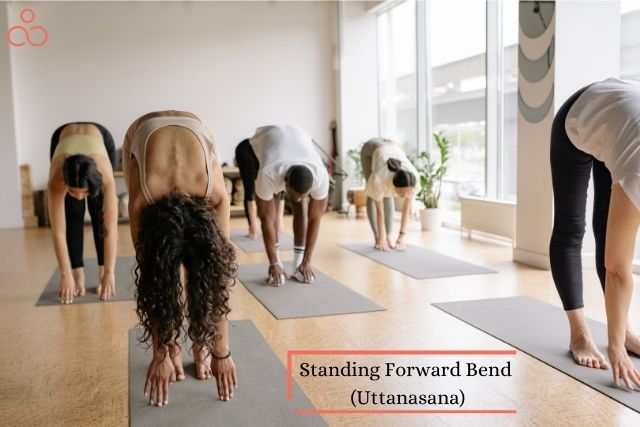
Benefits
Stretches and strengthens the hips, spine, lower back, shoulders, calves, and back of the thighs.
Steps to do it
- Start by standing on your Yoga mat with your feet hip-width apart (Tadasana).
- Take a deep breath and raise your arms with your fingers pointing upward, looking between your palms (Urdhva Hastasana).
- Maintain a straight back and slightly bent knees as you exhale while sweeping both arms to your sides and down to the floor. Take a glance between your knees.
- If possible, place your hands on the ground; if not, let them hang loosely or lay on your shins.
- Keep your shoulders from touching your ears. Instead of lowering your chest towards the ground, consider moving it to the level where it touches your knees.
- Breathe at a 4/8 rhythm for the next two to five minutes. Pay attention to how gravity stretches your spine as time passes and opens your lower back, enabling you to sink lower into the stretch and go closer to the floor.
3. Supine Spinal Twist (Supta Matsyendrasana)
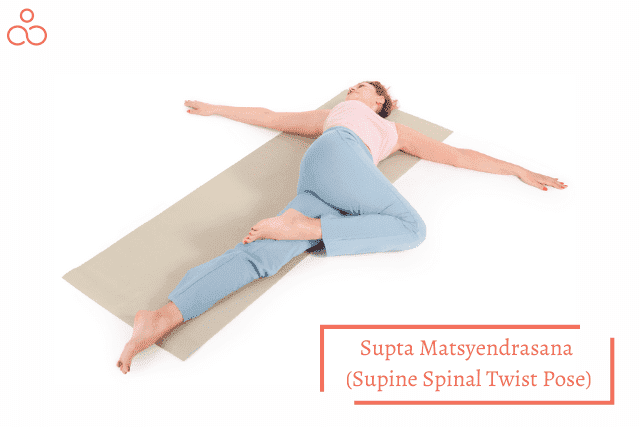
Benefits
Opens up and develops flexibility in the chest, pelvis, spine, hips, knees, and neck.
Steps to do it
- Lay down on your back to start, with your legs straight and your arms at your sides.
- Taking a deep breath, position your body in a ‘T’ shape by bringing your arms out to the sides.
- When you exhale, bend your right knee so that the heel of your right foot is level against the floor and your knee is almost touching your right buttock.
- Breathe in and steadily shift your bent right knee to the left while maintaining your left leg straight and looking to your right.
- Try to observe how your knee can go closer to the ground for two to five minutes while maintaining the same breathing technique (4/8).
- Then go back to the center and do the opposite side.
4. Plough Pose (Halasana)
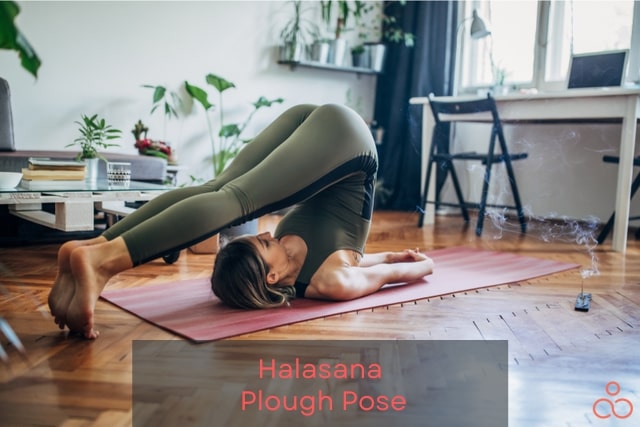
Benefits
Opens up and increases flexibility in the shoulders, thighs, wrists, spine, and pelvis.
Steps to do it
- Start by laying your entire body flat on the mat, and let your arms rest at your sides with your palms facing down.
- You can use your hands at the bottom of your back to provide support as you lift your hips and legs toward the ceiling while inhaling and engaging your core. Your torso should be aligned with the ground.
- As you slowly stretch your legs to enter a shoulder stand, breathe out (Salamba Sarvangasana). Spend a few breaths to settle in and notice how your body is feeling.
- Slowly depart the posture and relax in the child’s pose if you feel any pinching or acute aches in your back or spine (Balasana).
- After that, as you exhale, tighten your abdominal muscles to help your legs gently and steadily descend behind your head until the tips of your toes touch the ground.
- Your hands should be held in a V-shape, and your hips should be positioned squarely above your shoulders. You should maintain a slight gap between your chin and chest.
- If your toes have not yet touched the ground, aid your back with your hands so that you may extend your legs as far as you can while maintaining them straight.
- Breathe in a 4/8 rhythm while remaining in this position for two to five minutes. Observe how your spine is stretching and how your legs can sag farther behind you as gravity takes its course.
5. Garland Pose (Malasana)
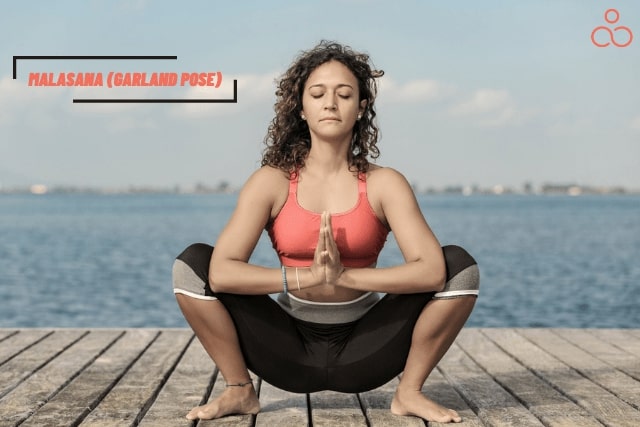
Benefits
Opens up and develops flexibility in the ankles, inner thighs, shoulders, lower back, and buttocks.
Steps to do it
- Put your feet approximately a mat’s width apart and stand up.
- To enter a squat, flex your knees and bring your butt down toward the floor.
- Your toes naturally want to point out, and that’s fine, but try not to overdo it. You eventually strive to maintain the feet somewhat parallel.
- Put your upper arms between your knees, bend your elbows, and do the “Anjali mudra” by bringing your palms together (prayer position).
- See if you can touch your sternum with your thumbs while holding the “Anjali mudra” position with your hands at your heart’s center to maintain a high chest. To stay engaged, keep pressing your upper arms into your thighs and your thighs into your upper arms.
- Maintain a straight spine, a butt toward the ground, and shoulders that are relaxed and wide apart from your ears.
- Take five deep breaths here, then straighten your legs to exit. If you want, you can enter a Forward Fold right away.
- To benefit from warming up, try repeating the posture three times. Alternating different positions with your squats while practicing at home is OK.
How to practice gravity Yoga: Important equipment and accessories for gravity Yoga
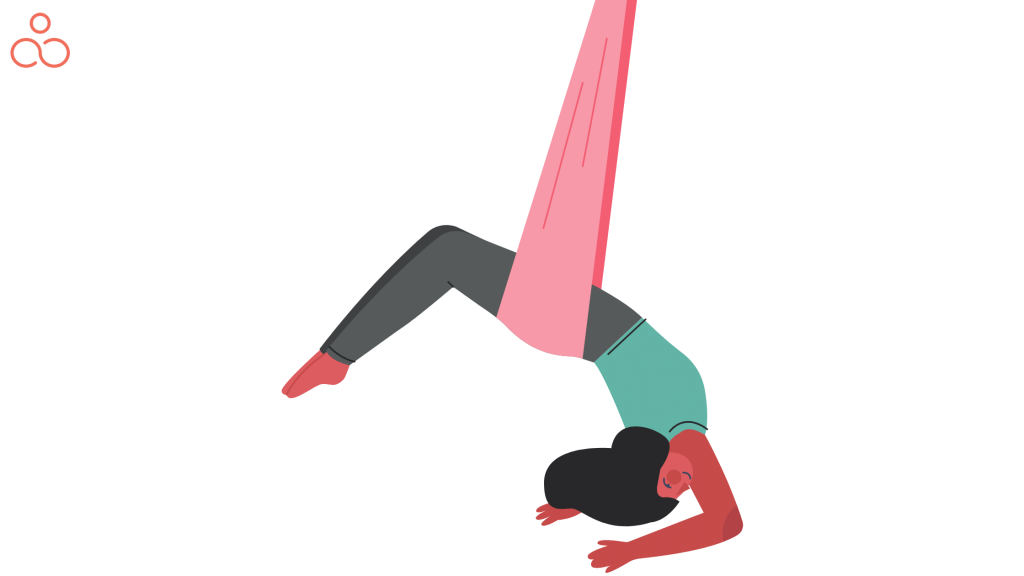
Gravity Yoga is a unique form of Yoga that utilizes inversion poses to increase flexibility and improve overall health. To practice gravity Yoga effectively, it is important to have the proper equipment and accessories. Here are some essential items:
- Yoga Hammock/Sling
This equipment is vital for practicing gravity Yoga. It allows you to suspend your body in the air, perform various inversion poses, and support your body.
- Yoga Mat
A non-slip Yoga mat is essential for practicing gravity Yoga. It provides a stable surface for your feet and helps prevent slips and falls.
- Yoga Blocks
Yoga blocks are highly beneficial in gravity Yoga as they provide support, help maintain proper alignment, and deepen stretches. Using Yoga blocks in various poses can enhance your flexibility, balance, and strength in gravity Yoga practice.
Straps can deepen stretches, improve balance, and provide support for difficult poses. Using the strap, gravity Yoga practitioners can enhance their flexibility, increase their range of motion, and reduce the risk of injury.
- Grip socks
Grip socks are essential for maintaining stability and preventing slips during gravity Yoga sessions. These socks provide extra traction and support, enhancing overall performance and safety during practice.
- Water bottle
Staying hydrated is important during any exercise routine, including gravity Yoga. It can help prevent dehydration and boost performance.
By adding these essential components to your gravity Yoga routine, you can amplify your workout experience and attain your desired fitness objectives.
5 Tips and tricks To Master Gravity Yoga For Beginners
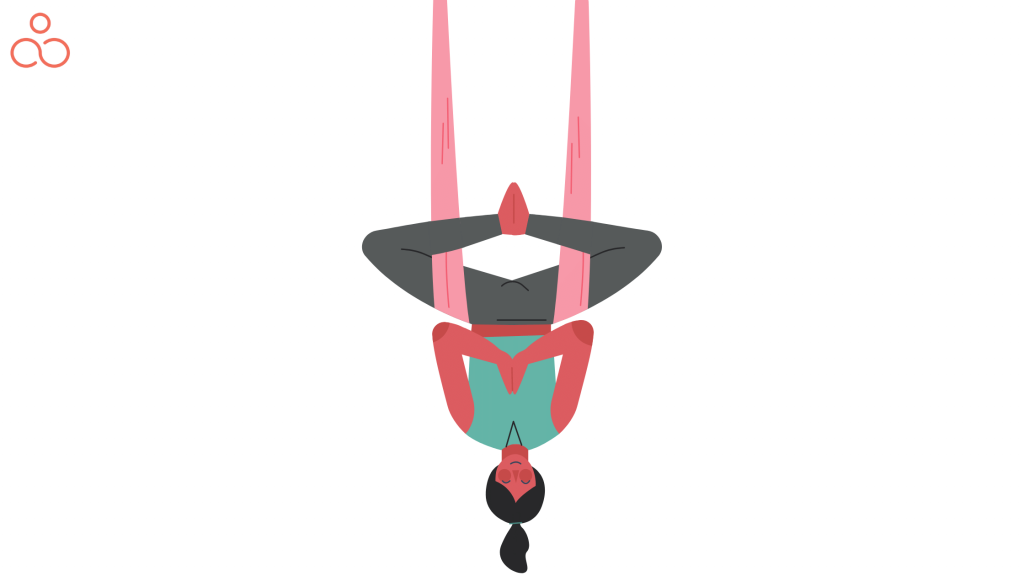
Gravity Yoga is a challenging practice that requires a lot of dedication and skill to master. Following are some helpful tips and tricks to assist you on your journey:
- Start with the basics
Before attempting any advanced poses, make sure you have a strong foundation in basic postures. This will help you build the strength and flexibility needed for more challenging moves.
- Focus on your breath
Breathing is an essential component of gravity Yoga. Make sure that you are breathing deeply and evenly throughout your practice, especially during challenging poses.
- Use props
Props such as blocks, straps, and blankets can help you to get into poses more efficiently and safely. Feel free to use them if you need to.
- Practice regularly
The key to mastering any Yoga practice is regular practice. Try to schedule at least a few sessions each week to keep your skills sharp.
- Listen to your body
Gravity Yoga can be intense, and it’s important to listen to your body and avoid pushing yourself beyond your limits. If a pose feels too difficult or uncomfortable, take a step back and try something else.
- Have fun
Some shapes may feel out of reach initially, especially if you’re new to Yoga. You may become confused and tangled, but if you remember that you’re just having fun, none will matter.
Some Facts about Anti Gravity Yoga with Benefits

- In the late ’90s, Anti Gravity Yoga emerged and gained popularity.
- The first Yoga swing, invented in the UK in 2001, featured silk harnesses with handles and footholds.
- Anti Gravity Yoga, a renowned form of aerial Yoga, combines Yoga poses, Pilates, calisthenics, and aerial activities on a hammock for a comprehensive workout.
- By 2011, the Yoga hammock and “aerial Yoga” trend surfaced with a 300-pound capacity system comprising carabiners, parachute hammock, webbing strap, and support chain.
- A Study revealed that the use of Anti Gravity fitness exercises in PE practice contributes to a significant increase in the static balance, body flexibility and muscle strength of young people’s hands for relatively healthy female students.
- Today, aerial Yoga classes and certified trainers are accessible worldwide.
Physiological and psychological benefits of Aerial Yoga
A full-body workout
Anti-gravity exercises allow for full-body stretching and muscle toning using just your body weight. It also relieves stress from bones and improves flexibility. Engaging core muscles can improve shoulder, spinal, and core flexibility.
Increases your stamina and helps ease discomfort
Anti-gravity Yoga can relieve tension in the hips and spine, and increase flexibility. It’s also a great post-recovery exercise for athletes.
Fights aging
Anti-gravity Yoga provides a boost of pleasant chemicals, enhances blood circulation, and promotes organ efficiency. It also stimulates neuronal connections in the brain, improving memory and promoting a youthful appearance.
Improves one’s mental well-being
Research shows that practicing aerial arts for the pleasure of movement significantly lowered stress and depression levels. This is incredibly encouraging for aerial Yoga, which encompasses yogic principles and is frequently more approachable and less competitive than a sideshow or formal acrobatics session.
I bet you’ll fall in love with the Anti Gravity Hammock. Let’s first explore…
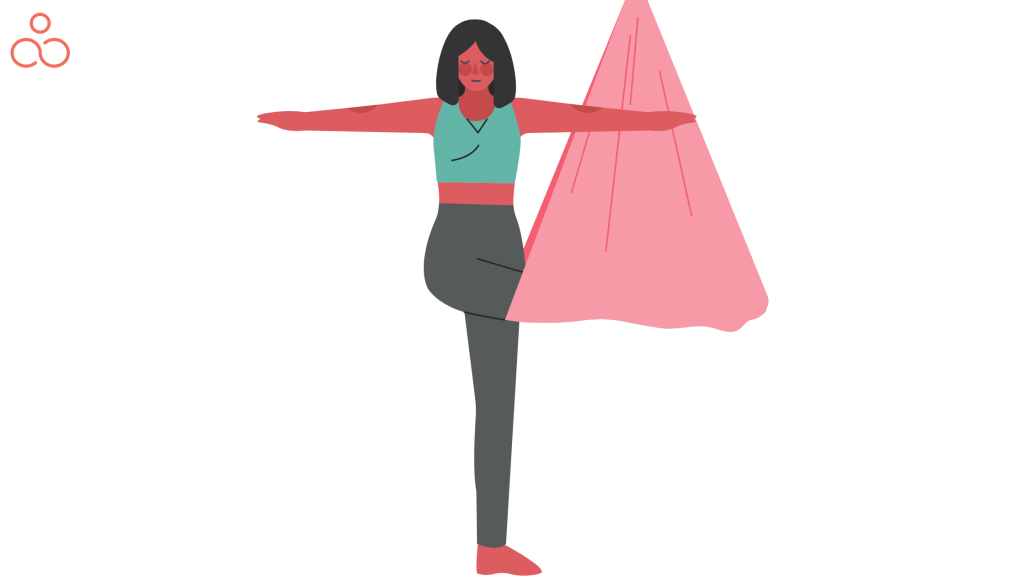
What is an Anti Gravity Yoga Hammock?
The Anti Gravity Hammock, also called a Yoga or silk hammock, was created by Christopher Harrison for aerial Yoga and fitness. He also invented the terms aerial Yoga and fitness, along with the Anti Gravity Fitness method and the Zero-Compression Inversion. It is now widely used in Anti Gravity Fitness and other aerial Yoga and fitness classes.
1. Simple and adaptable
One hammock may be used for various purposes, from therapeutic to child’s play and meditation.
2. Authenticity
The same material that is used by expert aerialists.
3. Engineering
Your Yoga and fitness practice will benefit from its unique tensile (resistance and stretch) properties, which maximize support and comfort.
4. Safety
Stress-tested to resist pressures greater than 1,000 lbs. (453 kg), click here to learn more.
5. Infinitely adjustable
For all sizes, ages, heights, and capabilities.
6. Simple to use
It is easy to set up.
7. Simple to clean
Machine washable, robust fabric.
8. Feels luxurious
Large fabric selection and color palette.
It’s more than simply a swing for Yoga exercises. Your Anti Gravity Hammock has a broad spectrum of uses, such as –
- Workouts
- Yoga
- Pilates
- Dance
- Therapeutics
- Meditation
- Play
- Relaxation
- Zero-Compression Inversion.
Anti Gravity Yoga Hammock Size Chart
All hammocks are 2.4-2.8 Meters or 9.2 feet wide so that you can stretch out in the fabric. To buy the right size anti gravity Yoga hammock, use this chart below:
| Ceiling Height | Length of the Hammock |
| 7-8 foot ceiling height | 4 Meters/4.4 Yard Hammock |
| 8-10 foot ceiling height | 5 Meters/5.5 Yard Hammock |
| 10+ foot ceiling height | Purchase longer rigging equipment or extended-length hammock. |
- A 60-inch width is mainly recommended for younger adults and children.
- Measurements of 75 inches and above, specifically for aerial Yoga poses such as aerial cocoon poses, are recommended for adults.
Did You Know?
Low-gravity Yoga is often practiced by astronauts to help them maintain their physical and mental health during long-duration space missions.
5 Most Common Myths And Misconceptions About Gravity Yoga That You Need To Know
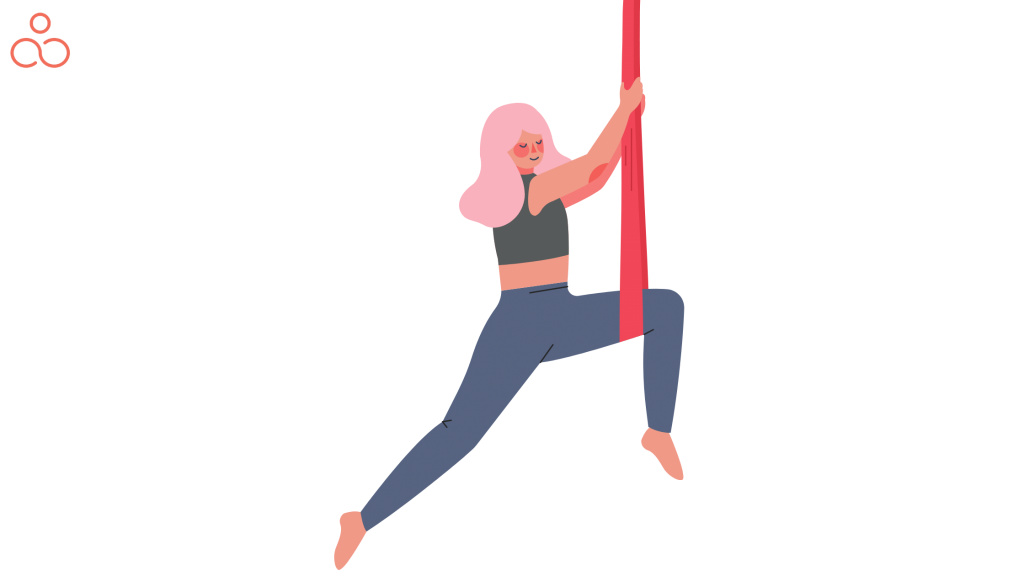
Gravity Yoga has gained popularity over the years but remains a mystery to some. There are many misconceptions surrounding gravity Yoga that are simply not true.
- Gravity Yoga is only for advanced yogis
This is simply not true. Gravity Yoga can be practiced by anyone, regardless of their Yoga experience or skill level. With the use of the Yoga trapeze, gravity Yoga offers a unique and accessible way to practice Yoga with the support of other props, allowing anyone to try it out for themselves.
- Gravity Yoga is only for young people
Gravity Yoga can be enjoyed by people of all ages. It’s a great, low-impact exercise for seniors.
- Gravity Yoga is only for flexible people
Gravity Yoga can help improve flexibility. So even if you’re not very flexible, you can still benefit.
- Gravity Yoga is only for stretching
While gravity Yoga is known for its stretching benefits, it offers much more than just that. Gravity Yoga can also improve balance, strength, and flexibility and provide a unique and fun way to exercise.
- Gravity Yoga is dangerous.
Like any physical activity, there is always some level of risk involved. However, when done correctly and with proper guidance, gravity Yoga is safe and beneficial for the body. Listening to your body and working within your limits are essential to avoid injury.
Therefore, gravity Yoga is a fun and accessible practice that offers numerous benefits for the body and mind. Don’t let these misconceptions hold you back from trying it out for yourself.
Frequently Asked Questions
What is low gravity Yoga?
Low gravity Yoga, also known as aerial Yoga or anti-gravity Yoga, is a modern form of Yoga that incorporates the use of a hammock or silk fabric suspended from the ceiling. This enables practitioners to perform various poses and stretches in mid-air, allowing for deeper stretches, enhanced flexibility, and reduced stress on joints compared to traditional Yoga.
Is gravity Yoga safe?
Yes, gravity Yoga is generally safe for most people. However, it is essential to practice under the guidance of a qualified instructor to ensure proper alignment and avoid injury.
What are the benefits of gravity Yoga?
Gravity Yoga has numerous benefits for both the body and mind such as
- Improved flexibility and balance
- Increased strength and endurance
- Reduced stress and tension
- Improved posture and alignment
- Enhanced respiratory and cardiovascular function.
What happens if I don’t perform Anti Gravity? Will it continue to improve my performance?
The Anti Gravity Hammock may make your aerial Yoga or fitness classes more enjoyable and beneficial, even if they are not Anti Gravity. An original aerial Yoga and fitness hammock is the Anti Gravity Hammock. The hammock’s fabric maximizes comfort and support, allowing you to move more freely and hold poses for extended periods.
Is it simple to hang an Anti Gravity Hammock? Does it include hardware?
Yes. Setting up the Anti Gravity Hammock is simple. High-quality hardware and simple-to-follow step-by-step instructions are included in the hammock kit. The hammock may be strung inside and outside from a door frame, a freestanding frame, or a ceiling.
Conclusion
As you now have a proper understanding of “what is gravity Yoga?”, “what is anti gravity Yoga?”, and “How do they differ from traditional Yoga?”
You can selectively engage and release muscles to deepen and safely enhance your posture by increasing your awareness of how gravity impacts your body. For those seeking a unique way to challenge their bodies beyond conventional Yoga, gravity Yoga has proven to be an effective workout. With just a mat, water, resistance weights, and proper footwear, you can effortlessly practice gravity Yoga at home. Indeed, there’s never been a better time for humans to embrace the power of gravity!
So, say goodbye to body stress and hello to the perks of intense workouts like Pilates. Break free from the monotony of typical exercises and Yoga poses—embrace the thrill of aerial Yoga!

